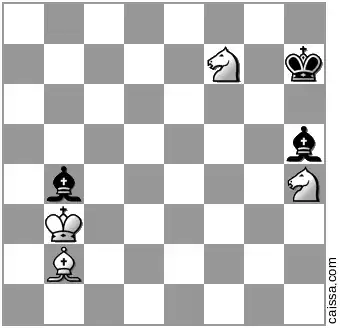I'm curious as to whether there are compositions of chess puzzles/problems where the solution really emphasizes the boundedness of the board. Put differently, cases where the solution would be impossible on an infinitely large board.
-
1There will be plenty of problems where the king gets mated on the border of the board. Do they qualify? – user1583209 Jan 18 '18 at 21:11
-
@user1583209 indeed they do, let's say for example the king+rook checkmate, but these are rather the more trivial examples. I was mainly hoping to find ones where some sort of a pattern/cycle breaks at some point because of the borders, I guess somewhat similar to phonon's king+bishop example. But in principle you are right that all border mates would be valid examples. I hope this clarifies it a bit :) – user929304 Jan 19 '18 at 16:04
-
None of the basic mates to a lonely king are possible on an infinite board – David May 28 '19 at 06:35
-
Which suggests a related problem - boards infinite in one direction (e.g. left-right) but finite in the orthogonal one. – Ian Bush May 29 '19 at 02:31
3 Answers
Now that's a refreshingly different kind of question :)
It's probably easier to compose such a problem than to search for one, but that said, there's one that comes to mind:
[Title "White to play and win"]
[fen "8/5N1k/8/7b/1b5N/1K6/1B6/8 w - - 0 2"]
(Study by Henri Rinck)
Hint:
You want to keep all 3 pieces as white in order to win. Try to set up a trap on the
b4bishop by setting up a discovery on the black king.
Solution:
1.Ng5+ Kh6 {only possible attempt to keep material} 2.Bc1 {Double threat: discovery on the king and threatening to take on b4, the trap is set} Ba5 {Any other move drops the bishop to a discovery check} 3.Ka4 Bb6 {only move again} 4.Kb5 Ba7 5.Ka6 Bb8 6.Kb7 {bishop falls.} From move
3.Ka4it had become clear where this is going: the white king keeps shouldering the bishop until it hits a wall and cannot escape anymore. Now on an infinite board, this trap would have been impossible as the king and bishop dance would have continued endlessly.
-
Too remarks: - I don't know why you wrote "zugzwang" after 2.Bc1. This is not zugzwang. - On an infinite chessboard, Black could even afford to give his Bb4, since 3 pieces vs 1 would be a draw (actually I'm not sure about 3 minor pieces vs a bare king on an infinite chessboard !) – Evargalo Jan 19 '18 at 08:32
-
@Evargalo Good remarks. This was hastily written, indeed one doesn't really call this a Zugzwang rather just a double threat. As for the infinite case, it doesn't even come to whether the 3 piece combo will be enough or not because black will be able to save the bishop anyway, and that already makes for a different scenario compared to the finite case altogether. This was just an example (among many one can come up with) to showcase the boundaries of the board being employed in a trap situation in order to illustrate the role of the finiteness. – Ellie Jan 19 '18 at 15:51
-
I agree (+1). My third remark: you should credit the author of this study (I am 99% sure he is André Chéron). – Evargalo Jan 19 '18 at 16:30
-
@Evargalo wow that'd be quite neat if you've correctly identified the author of the puzzle! I myself only recall having seen it as part of chess.com's tactics trainer. – Ellie Jan 19 '18 at 16:43
-
Refreshingly different? It's been years since the last time I've seen an actual chess question here! – David May 28 '19 at 06:37
-
@David Note that this post and answer are more than a year old :-) What kind of chess questions you mean? (that you haven't seen) Would these 1, 2, 3, ... among others not qualify as proper interesting chess questions? :p – user929304 May 28 '19 at 09:53
-
On an infinite chess board, the king wouldn't be able to chase the bishop to begin with; Black could simply do 2 ... h10. – Acccumulation May 01 '21 at 22:43
Is this the sort of problem you're looking for?
[Title "Erich Bartel. Augsburger Allgemeine, 10 Feb 2001, no.628. #6"]
[StartFlipped "0"]
[fen "8/7Q/3b2B1/1K6/3k4/4p3/8/8 w KQkq - 0 1"]
- Bb1! Ke5 (1... e2? 2. Qe4+) 2. Qf5+ Kd4 3. Qe4+ Kc3 4. Qd3+ Kb2 5. Qc2+ Ka1 6. Qa2#
It is P1126265 in the PDB.
- 17,514
- 4
- 67
- 113
- 6,305
- 2
- 19
- 36
A problem must surely demonstrate the finiteness of the board if it has two twins, the solutions are essentially different, and the twinning is by shifting every unit 1 file to the right. Or, regarding the units as fixed, by cutting the empty h-file off the right-hand side and pasting it to the left-hand side.
[Title "Heinz Däubler. Augsburger Allgemeine, 23 Sep 2006, no. 919a. P1197652"]
[fen "1B6/1B6/8/1k6/8/1K6/8/1N6 w - - 0 1"]
[StartFlipped "0"]
- Ba7 Ka5 2. Kc4 {Na3? stalemates} Ka4 3. Bb8 Ka5 4. Bc7+ Ka4 5. Bc6#
and
[Title "ditto, all 1 file to the right"]
[fen "2B5/2B5/8/2k5/8/2K5/8/2N5 w - - 0 1"]
[StartFlipped "0"]
- Bb7 Kb5 2. Nb3 {Kd4? Kb4 3 and bK escapes to the a-file and White can't mate in time} Ka4 3. Bd6 Kb5 4. Bc5 Ka4 5. Bc6#
- 6,305
- 2
- 19
- 36
